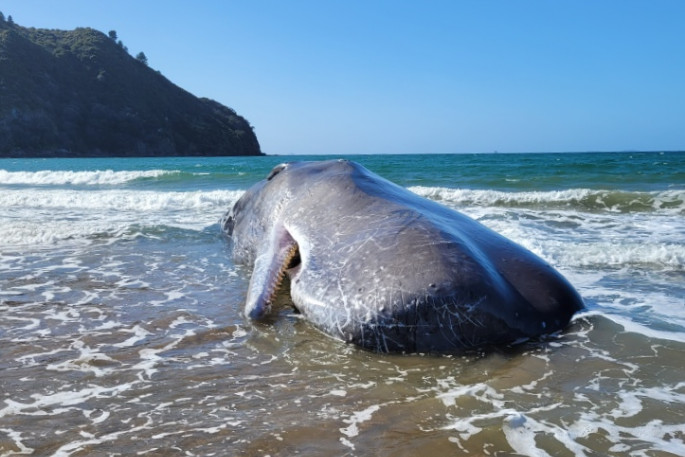A rāhui in place in on a Coromandel Beach following the beaching of a dead sperm whale has now been lifted.
The 16-metre sperm whale beached at Matapaua Bay on Saturday, October 22.
A rāhui was placed over Wharekaho Beach five days ago.
In a statement to SunLive today, the Department of Conservation says the flensing process of the deceased sperm whale at Matapaua beach has now been completed and the rahui lifted.
'The materials flensed from the whale, named Puhiwai Rangi, will be used for traditional Mātauranga Māori and cultural practices, with the remainder of the whale being buried,” says a DOC spokesperson.
Flensing is the removing of the blubber or outer integument of whales, separating it from the animal's meat.
'DOC and Ngāti Hei woud like to thank Ngātiwai, Hori Parata and his team, Hauraki iwi, the people of Matapaua, Whitianga and Coromandel, Rae and Eddy (Roadworx), John from Trojan Marine, Project Jonah (who were consulted by DOC on arrival at the site), Thames-Coromandel District Council, Waikato regional Council, and New Zealand Police. '
Questions asked since the whale was found deceased:
Q. Why was the whale moved?
A. The original site of the decreased whale was logistically difficult to operate within and it would not have been possible to bury the whale there.
Q. Why wasn't the whale disposed of at sea?
A. Disposal at sea would have created a maritime safety issue. The whale may have also returned to shore at a later date.
Q. Why was a rāhui placed?
A. Rāhui was put in place to protect the public – there was short term contamination at the site and also the risk of marine predators being attracted to the area.
Q. How much did the operation cost?
A. Final costs are not available. Costs are shared by DOC and Ngāti Hei. A lot of time was donated to the kaupapa by iwi and the community who supported.
Q. Was there much disturbance to the dunes?
A. The dunes and their biodiversity values were protected during the process and three dotterel chicks hatched during the event.
Information on sperm whales can be found on the DOC website here: Sperm whales: New Zealand marine mammals (doc.govt.nz)



3 comments
whale
Posted on 28-10-2022 15:03 | By dumbkof2
should have been towed way out to sea and then blown up lots of food for the other ocean fishes
Hmmm
Posted on 28-10-2022 18:00 | By Let's get real
Prior to European arrival, customary practices would not have involved chainsaws or metal tools of any description. How about we have some honesty and quit the absolute nonsense around customary practices and admissions about the truth behind this barbarism. Money.
whale
Posted on 29-10-2022 09:06 | By dumbkof2
should have been towed far out to sea blown up making food for other sea creatures. surely this would have aligned more with maori coulture than flensing or taking other parts of the body
Leave a Comment
You must be logged in to make a comment.